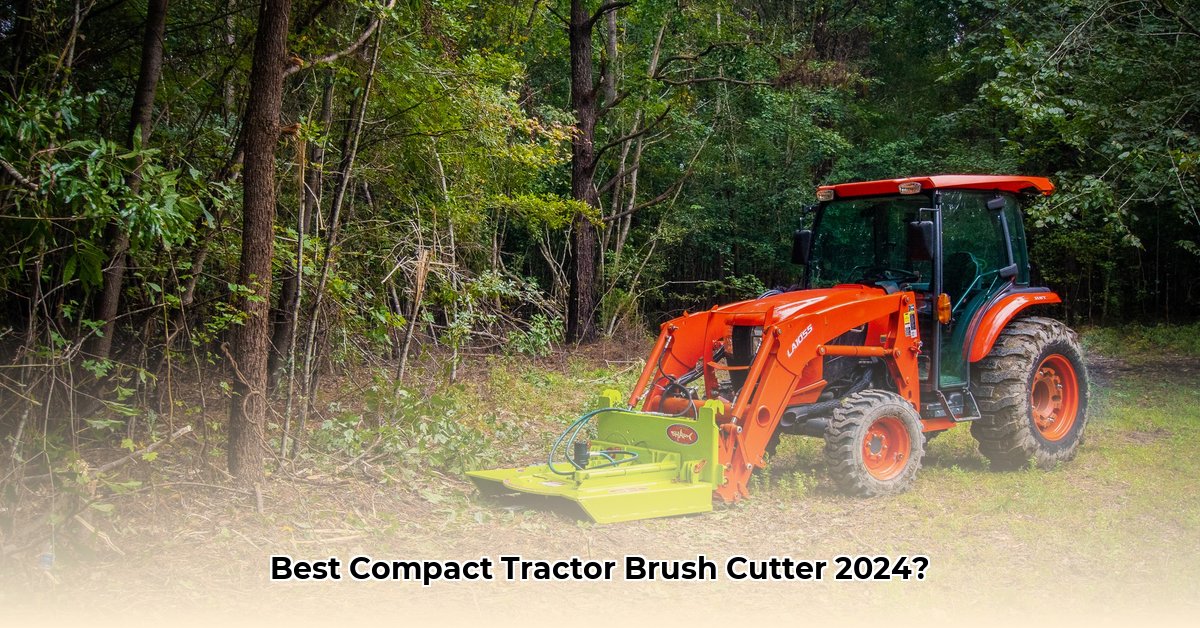
Transforming overgrown fields and unruly landscapes into manicured spaces is easier than you think. The right compact tractor brush cutter can significantly boost efficiency and cost-effectiveness. This comprehensive buyer's guide navigates the complexities of choosing the ideal machine for your needs, from understanding key features to making informed brand comparisons. We also address crucial safety considerations and the often-overlooked issue of lead times. For more information on compact tractors, check out this helpful resource.
Key Features to Consider When Choosing a Compact Tractor Brush Cutter
Selecting the right brush cutter is akin to choosing the perfect tool for a specific job. This section highlights the critical features to help determine the best compact tractor brush cutter for your needs.
Cutting Width: A wider cutting swathe translates to faster clearing times, but requires a more powerful tractor. Consider the typical size of the areas you plan to clear. (Wider cuts are more efficient, but require more horsepower).
Horsepower Requirements: Your tractor must possess sufficient horsepower to power the brush cutter effectively. Mismatches can lead to inefficient performance or even damage to your equipment. Always consult your tractor's manual to ensure compatibility. (Insufficient horsepower leads to strain and potential damage).
Power Take-Off (PTO) Compatibility: The PTO is the power transfer mechanism between your tractor and the brush cutter. Verify compatibility to ensure seamless operation. (Incorrect PTO connections are dangerous).
Blade Type: Two primary types exist:
- Flail Cutters: These utilize numerous small, swinging hammers, ideal for smaller vegetation and producing a fine, even cut. (Best for smaller debris).
- Disc Cutters: These feature larger, rotating discs, suitable for tackling tougher vegetation such as thick brush and small saplings. (More aggressive cutting; debris dispersal is a consideration).
Hydraulic System: Some cutters have self-contained hydraulic systems, others rely on your tractor's system. (Self-contained systems have straightforward mechanics while tractor-powered systems may provide greater power).
Quick-Attach Mechanisms: Easy attachment and detachment mechanisms save valuable time and effort when switching tasks. (Simple, efficient design is key).
Safety Features: Essential safety features include shields, emergency shut-offs, and robust construction. (Prioritize models with comprehensive safety features).
Ease of Use: An intuitive and user-friendly design greatly simplifies operation. (Simplicity and ease of operation should be valued).
Types of Compact Tractor Brush Cutters: Flail vs. Disc – Which is Right for You?
While the previous section touched on the differences, we will elaborate further. Flail cutters are gentler, producing a finer cut ideal for smaller jobs. Disc cutters are more aggressive, better suited for thick brush and saplings but producing a rougher cut and potentially scattering debris over a wider area. The choice largely depends on the typical vegetation you'll be clearing. Isn't it important to understand the differences?
Budgeting and Cost of Ownership: More Than Just the Sticker Price
The initial purchase cost only represents a fraction of the total cost of ownership. Factor in:
- Initial Purchase Price: Prices vary considerably based on size, features, and brand.
- Maintenance Costs: Regular maintenance, including blade sharpening, lubrication, and oil changes, accumulates over time.
- Repair Costs: Unexpected repairs are an inherent aspect of owning equipment. Budget for this contingency.
- Storage Costs: Appropriate storage is required to protect your investment from the elements.
Brand Comparisons: (Limited Data Available)
Given space and data constraints, a detailed comparison across specific brands is not feasible in this article. Referencing online reviews and consulting with equipment dealers can help you find reputable brands and models. What are some of the leading brands currently available in your region?
Addressing Lead Times: Planning for Delays
Lead times for compact tractor brush cutters can be lengthy, sometimes stretching for several months. Ordering well in advance of your anticipated need is crucial to avoid delays. Always confirm delivery estimates directly with suppliers before placing an order. Have you considered ordering several months in advance?
Reviews from Real Users: Synthesizing Experiences
While numerous users praise the efficiency and ease of use of modern compact tractor brush cutters, several reported minor issues such as missing grease fittings or loose bolts. These small problems highlight the importance of pre-delivery equipment inspections. It is also crucial to verify product reviews with a reputable independent source to eliminate biased reviews.
Safety Considerations: Prioritizing Safe Operating Procedures
Operating a compact tractor brush cutter safely requires strict adherence to certain precautions.
- Read the Operator's Manual: Understand the equipment’s operation and safety features in depth.
- Wear Appropriate Personal Protective Equipment (PPE): Eye protection, hearing protection, gloves, and sturdy footwear are mandatory.
- Prepare the Work Area: Clear the area of obstacles and ensure a safe working environment.
- Regular Maintenance: Regular attention to maintenance significantly reduces the risk of accidents.
Conclusion: Choosing Wisely
Choosing a compact tractor brush cutter requires careful consideration of numerous factors. Through thorough research and planning, you can confidently select a model that meets your needs, maximizes efficiency, and ensures safety. Prioritizing quality, researching brands, and planning ahead guarantees a successful purchase. Remember, a well-informed decision pays off in the long run.